An Analysis of Standardisation versus Adaptation in Global Marketing
VerifiedAdded on 2023/01/09
|9
|2540
|32
Report
AI Summary
This report delves into the critical strategies of global marketing, specifically contrasting standardisation and adaptation. Standardisation involves applying uniform marketing approaches globally, leveraging economies of scale and creating a consistent brand image. The report highlights advantages such as faster setup times and cost reduction but also acknowledges disadvantages like insensitivity to cultural differences and potential loss of uniqueness. Adaptation, conversely, tailors marketing strategies to local market needs, emphasizing consumerization and addressing cultural, legal, and technical constraints. The advantages include enhanced consumer relevance and the ability to outperform competitors, but it also acknowledges the complexity of adapting to diverse markets. The conclusion emphasizes that both strategies can coexist, and the optimal approach depends on specific market conditions, product types, and company objectives, aiming to provide valuable insights for businesses navigating the global market landscape.
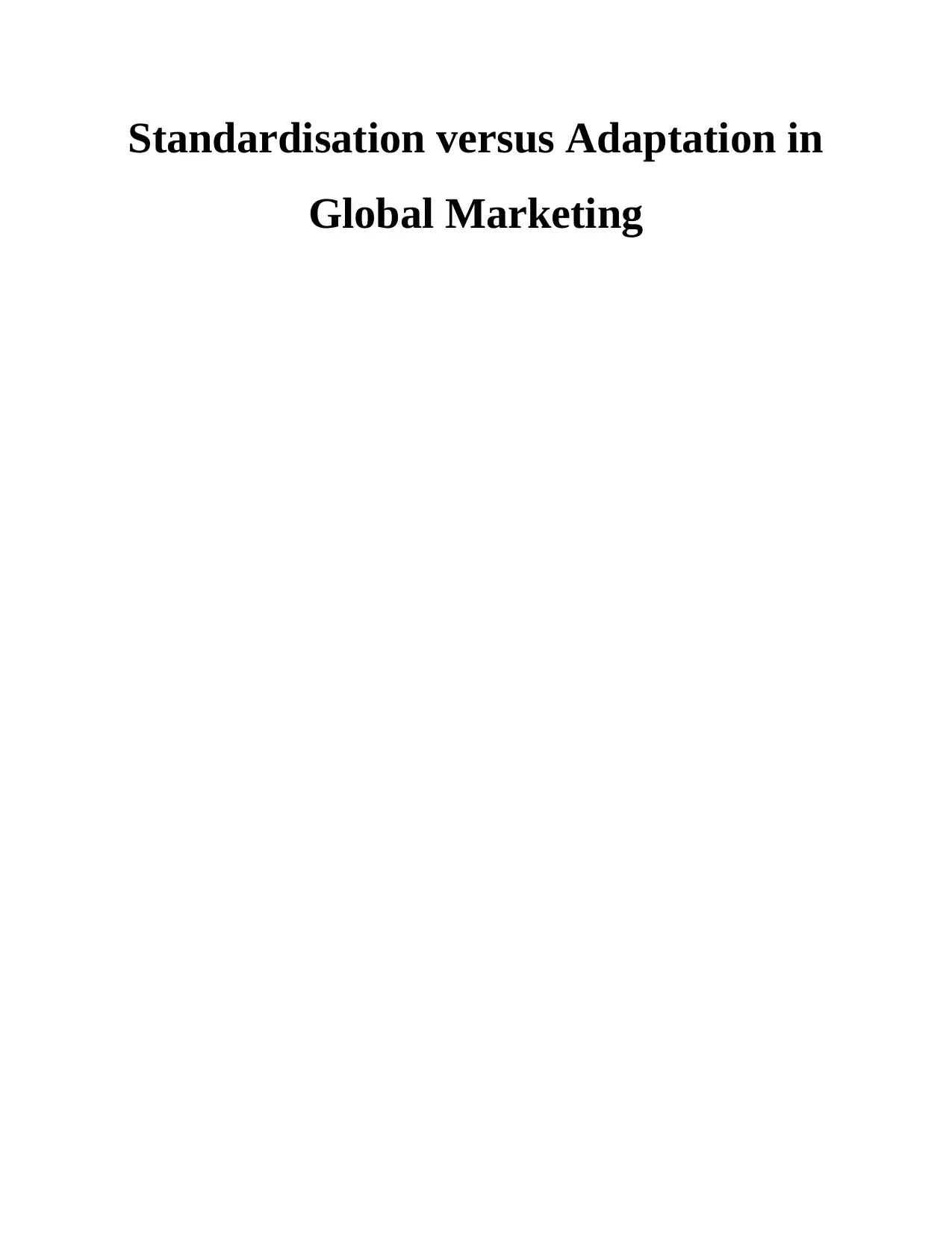
Standardisation versus Adaptation in
Global Marketing
Global Marketing
Paraphrase This Document
Need a fresh take? Get an instant paraphrase of this document with our AI Paraphraser
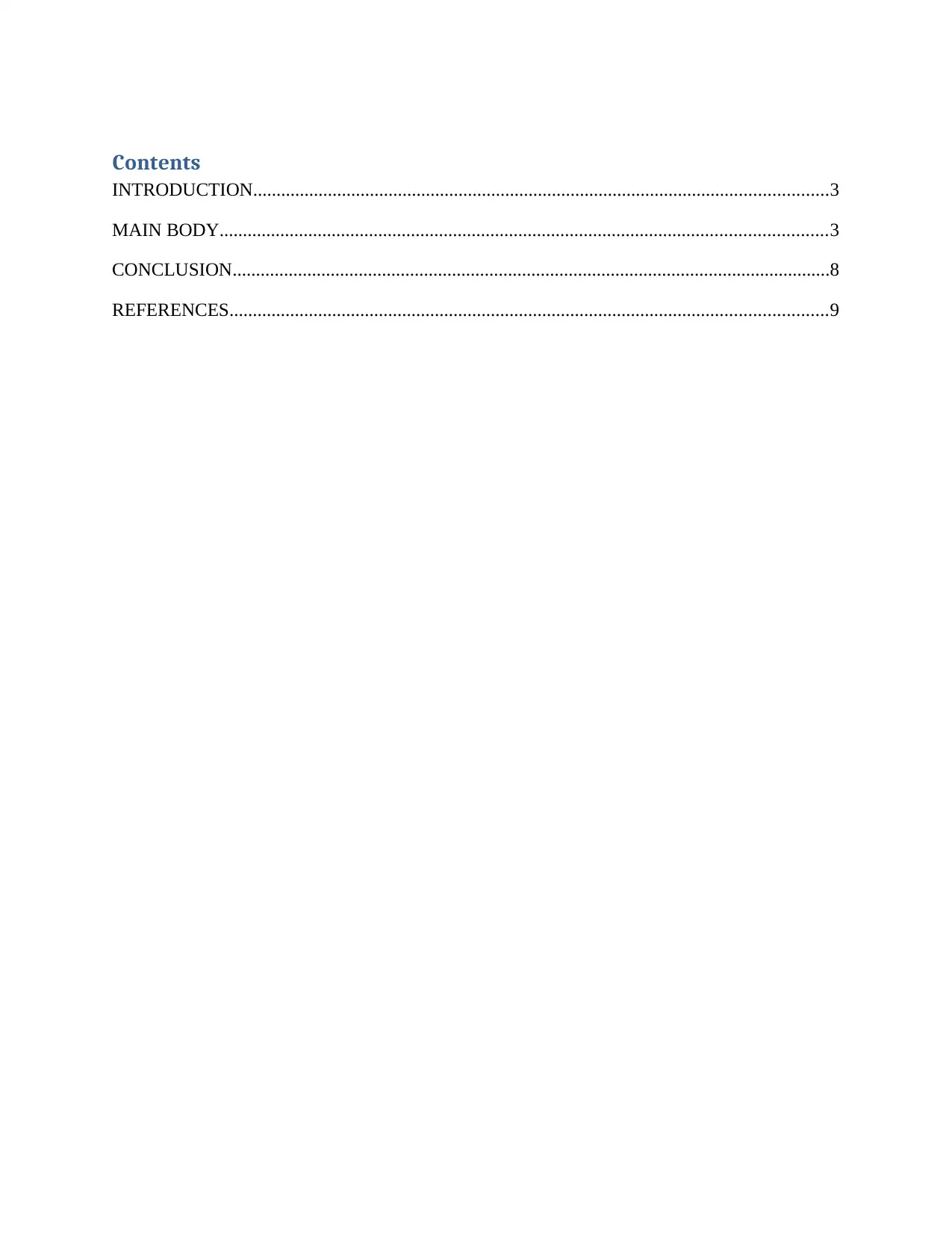
Contents
INTRODUCTION...........................................................................................................................3
MAIN BODY..................................................................................................................................3
CONCLUSION................................................................................................................................8
REFERENCES................................................................................................................................9
INTRODUCTION...........................................................................................................................3
MAIN BODY..................................................................................................................................3
CONCLUSION................................................................................................................................8
REFERENCES................................................................................................................................9
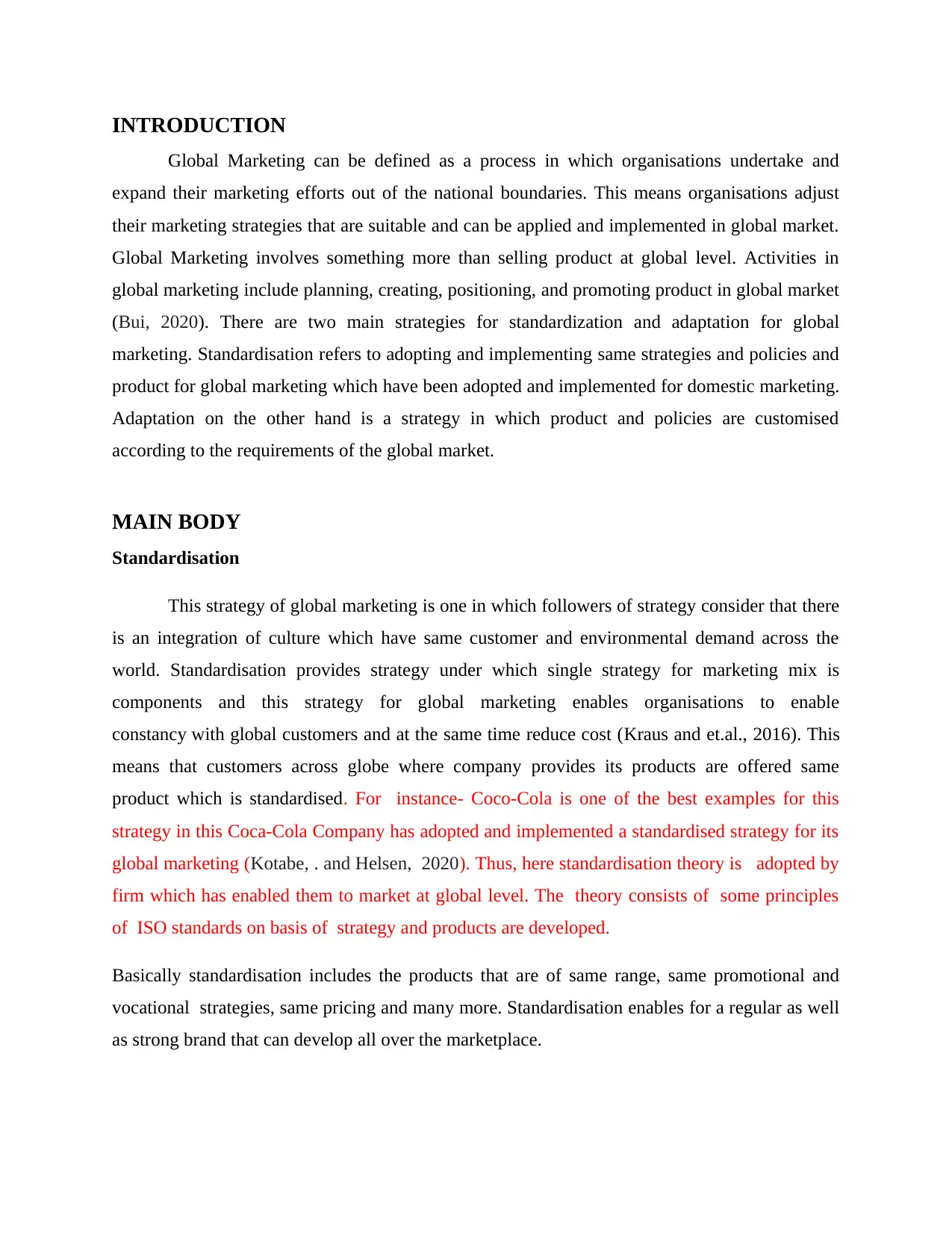
INTRODUCTION
Global Marketing can be defined as a process in which organisations undertake and
expand their marketing efforts out of the national boundaries. This means organisations adjust
their marketing strategies that are suitable and can be applied and implemented in global market.
Global Marketing involves something more than selling product at global level. Activities in
global marketing include planning, creating, positioning, and promoting product in global market
(Bui, 2020). There are two main strategies for standardization and adaptation for global
marketing. Standardisation refers to adopting and implementing same strategies and policies and
product for global marketing which have been adopted and implemented for domestic marketing.
Adaptation on the other hand is a strategy in which product and policies are customised
according to the requirements of the global market.
MAIN BODY
Standardisation
This strategy of global marketing is one in which followers of strategy consider that there
is an integration of culture which have same customer and environmental demand across the
world. Standardisation provides strategy under which single strategy for marketing mix is
components and this strategy for global marketing enables organisations to enable
constancy with global customers and at the same time reduce cost (Kraus and et.al., 2016). This
means that customers across globe where company provides its products are offered same
product which is standardised. For instance- Coco-Cola is one of the best examples for this
strategy in this Coca-Cola Company has adopted and implemented a standardised strategy for its
global marketing (Kotabe, . and Helsen, 2020). Thus, here standardisation theory is adopted by
firm which has enabled them to market at global level. The theory consists of some principles
of ISO standards on basis of strategy and products are developed.
Basically standardisation includes the products that are of same range, same promotional and
vocational strategies, same pricing and many more. Standardisation enables for a regular as well
as strong brand that can develop all over the marketplace.
Global Marketing can be defined as a process in which organisations undertake and
expand their marketing efforts out of the national boundaries. This means organisations adjust
their marketing strategies that are suitable and can be applied and implemented in global market.
Global Marketing involves something more than selling product at global level. Activities in
global marketing include planning, creating, positioning, and promoting product in global market
(Bui, 2020). There are two main strategies for standardization and adaptation for global
marketing. Standardisation refers to adopting and implementing same strategies and policies and
product for global marketing which have been adopted and implemented for domestic marketing.
Adaptation on the other hand is a strategy in which product and policies are customised
according to the requirements of the global market.
MAIN BODY
Standardisation
This strategy of global marketing is one in which followers of strategy consider that there
is an integration of culture which have same customer and environmental demand across the
world. Standardisation provides strategy under which single strategy for marketing mix is
components and this strategy for global marketing enables organisations to enable
constancy with global customers and at the same time reduce cost (Kraus and et.al., 2016). This
means that customers across globe where company provides its products are offered same
product which is standardised. For instance- Coco-Cola is one of the best examples for this
strategy in this Coca-Cola Company has adopted and implemented a standardised strategy for its
global marketing (Kotabe, . and Helsen, 2020). Thus, here standardisation theory is adopted by
firm which has enabled them to market at global level. The theory consists of some principles
of ISO standards on basis of strategy and products are developed.
Basically standardisation includes the products that are of same range, same promotional and
vocational strategies, same pricing and many more. Standardisation enables for a regular as well
as strong brand that can develop all over the marketplace.
⊘ This is a preview!⊘
Do you want full access?
Subscribe today to unlock all pages.

Trusted by 1+ million students worldwide
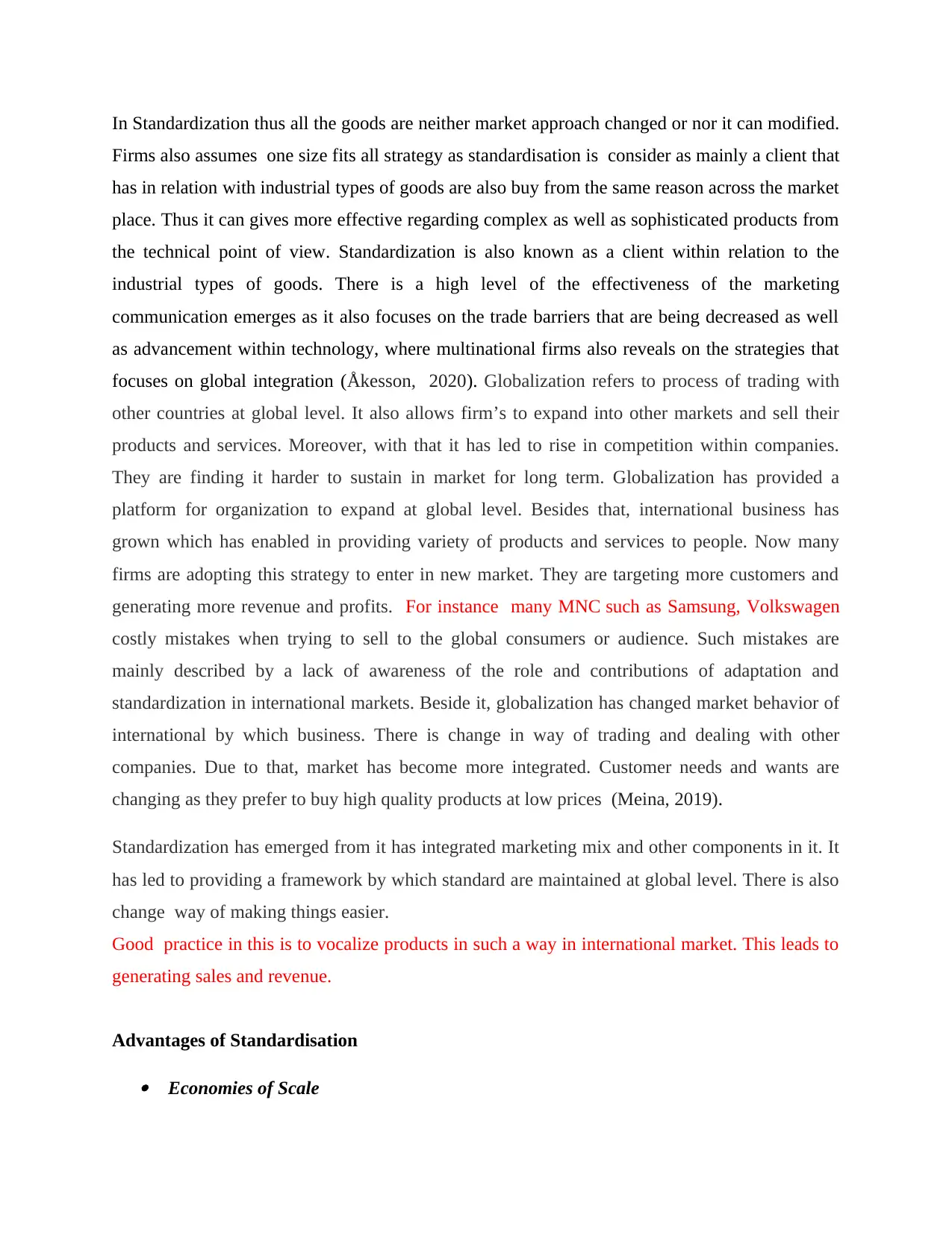
In Standardization thus all the goods are neither market approach changed or nor it can modified.
Firms also assumes one size fits all strategy as standardisation is consider as mainly a client that
has in relation with industrial types of goods are also buy from the same reason across the market
place. Thus it can gives more effective regarding complex as well as sophisticated products from
the technical point of view. Standardization is also known as a client within relation to the
industrial types of goods. There is a high level of the effectiveness of the marketing
communication emerges as it also focuses on the trade barriers that are being decreased as well
as advancement within technology, where multinational firms also reveals on the strategies that
focuses on global integration (Åkesson, 2020). Globalization refers to process of trading with
other countries at global level. It also allows firm’s to expand into other markets and sell their
products and services. Moreover, with that it has led to rise in competition within companies.
They are finding it harder to sustain in market for long term. Globalization has provided a
platform for organization to expand at global level. Besides that, international business has
grown which has enabled in providing variety of products and services to people. Now many
firms are adopting this strategy to enter in new market. They are targeting more customers and
generating more revenue and profits. For instance many MNC such as Samsung, Volkswagen
costly mistakes when trying to sell to the global consumers or audience. Such mistakes are
mainly described by a lack of awareness of the role and contributions of adaptation and
standardization in international markets. Beside it, globalization has changed market behavior of
international by which business. There is change in way of trading and dealing with other
companies. Due to that, market has become more integrated. Customer needs and wants are
changing as they prefer to buy high quality products at low prices (Meina, 2019).
Standardization has emerged from it has integrated marketing mix and other components in it. It
has led to providing a framework by which standard are maintained at global level. There is also
change way of making things easier.
Good practice in this is to vocalize products in such a way in international market. This leads to
generating sales and revenue.
Advantages of Standardisation
Economies of Scale
Firms also assumes one size fits all strategy as standardisation is consider as mainly a client that
has in relation with industrial types of goods are also buy from the same reason across the market
place. Thus it can gives more effective regarding complex as well as sophisticated products from
the technical point of view. Standardization is also known as a client within relation to the
industrial types of goods. There is a high level of the effectiveness of the marketing
communication emerges as it also focuses on the trade barriers that are being decreased as well
as advancement within technology, where multinational firms also reveals on the strategies that
focuses on global integration (Åkesson, 2020). Globalization refers to process of trading with
other countries at global level. It also allows firm’s to expand into other markets and sell their
products and services. Moreover, with that it has led to rise in competition within companies.
They are finding it harder to sustain in market for long term. Globalization has provided a
platform for organization to expand at global level. Besides that, international business has
grown which has enabled in providing variety of products and services to people. Now many
firms are adopting this strategy to enter in new market. They are targeting more customers and
generating more revenue and profits. For instance many MNC such as Samsung, Volkswagen
costly mistakes when trying to sell to the global consumers or audience. Such mistakes are
mainly described by a lack of awareness of the role and contributions of adaptation and
standardization in international markets. Beside it, globalization has changed market behavior of
international by which business. There is change in way of trading and dealing with other
companies. Due to that, market has become more integrated. Customer needs and wants are
changing as they prefer to buy high quality products at low prices (Meina, 2019).
Standardization has emerged from it has integrated marketing mix and other components in it. It
has led to providing a framework by which standard are maintained at global level. There is also
change way of making things easier.
Good practice in this is to vocalize products in such a way in international market. This leads to
generating sales and revenue.
Advantages of Standardisation
Economies of Scale
Paraphrase This Document
Need a fresh take? Get an instant paraphrase of this document with our AI Paraphraser
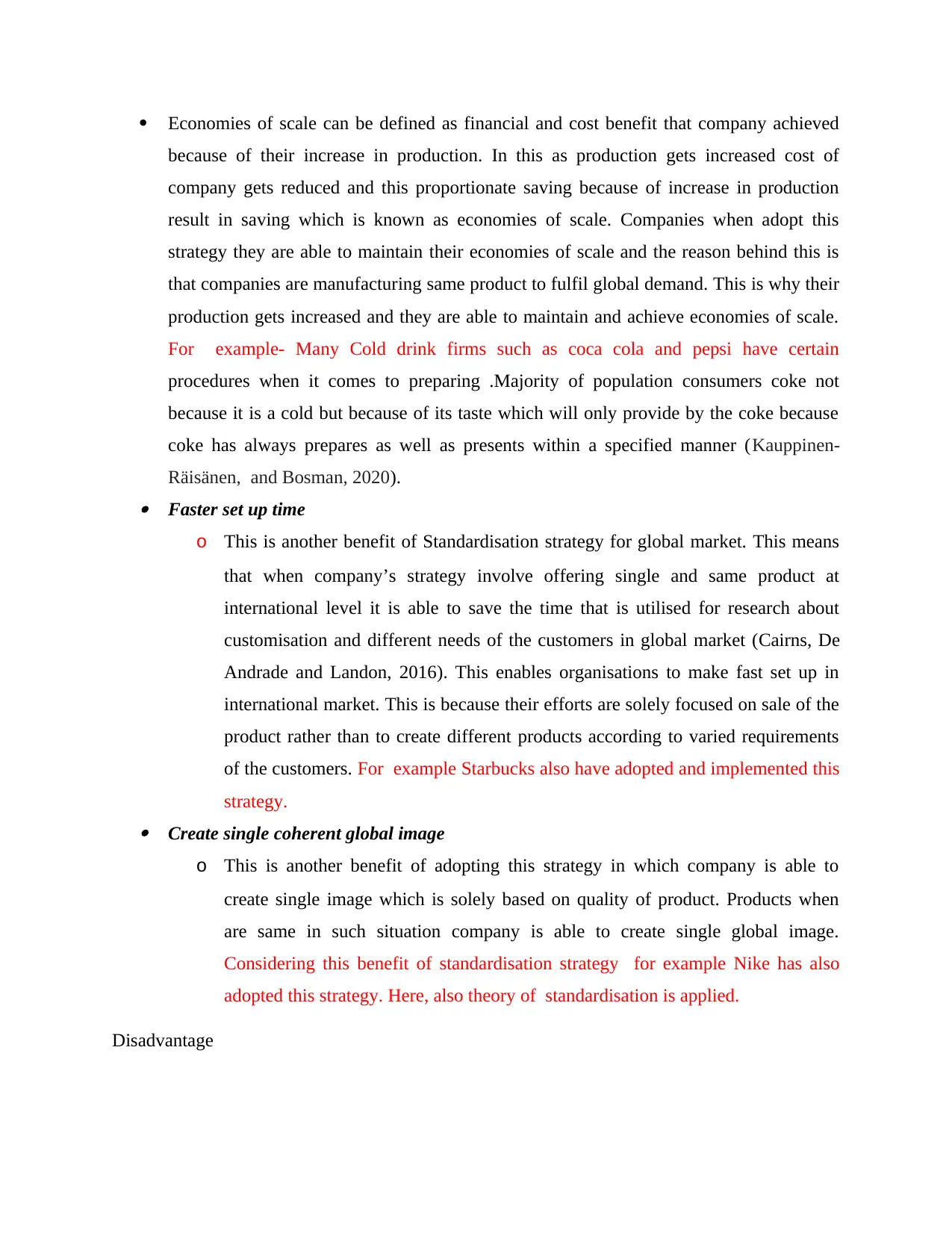
Economies of scale can be defined as financial and cost benefit that company achieved
because of their increase in production. In this as production gets increased cost of
company gets reduced and this proportionate saving because of increase in production
result in saving which is known as economies of scale. Companies when adopt this
strategy they are able to maintain their economies of scale and the reason behind this is
that companies are manufacturing same product to fulfil global demand. This is why their
production gets increased and they are able to maintain and achieve economies of scale.
For example- Many Cold drink firms such as coca cola and pepsi have certain
procedures when it comes to preparing .Majority of population consumers coke not
because it is a cold but because of its taste which will only provide by the coke because
coke has always prepares as well as presents within a specified manner (Kauppinen-
Räisänen, and Bosman, 2020). Faster set up time
o This is another benefit of Standardisation strategy for global market. This means
that when company’s strategy involve offering single and same product at
international level it is able to save the time that is utilised for research about
customisation and different needs of the customers in global market (Cairns, De
Andrade and Landon, 2016). This enables organisations to make fast set up in
international market. This is because their efforts are solely focused on sale of the
product rather than to create different products according to varied requirements
of the customers. For example Starbucks also have adopted and implemented this
strategy. Create single coherent global image
o This is another benefit of adopting this strategy in which company is able to
create single image which is solely based on quality of product. Products when
are same in such situation company is able to create single global image.
Considering this benefit of standardisation strategy for example Nike has also
adopted this strategy. Here, also theory of standardisation is applied.
Disadvantage
because of their increase in production. In this as production gets increased cost of
company gets reduced and this proportionate saving because of increase in production
result in saving which is known as economies of scale. Companies when adopt this
strategy they are able to maintain their economies of scale and the reason behind this is
that companies are manufacturing same product to fulfil global demand. This is why their
production gets increased and they are able to maintain and achieve economies of scale.
For example- Many Cold drink firms such as coca cola and pepsi have certain
procedures when it comes to preparing .Majority of population consumers coke not
because it is a cold but because of its taste which will only provide by the coke because
coke has always prepares as well as presents within a specified manner (Kauppinen-
Räisänen, and Bosman, 2020). Faster set up time
o This is another benefit of Standardisation strategy for global market. This means
that when company’s strategy involve offering single and same product at
international level it is able to save the time that is utilised for research about
customisation and different needs of the customers in global market (Cairns, De
Andrade and Landon, 2016). This enables organisations to make fast set up in
international market. This is because their efforts are solely focused on sale of the
product rather than to create different products according to varied requirements
of the customers. For example Starbucks also have adopted and implemented this
strategy. Create single coherent global image
o This is another benefit of adopting this strategy in which company is able to
create single image which is solely based on quality of product. Products when
are same in such situation company is able to create single global image.
Considering this benefit of standardisation strategy for example Nike has also
adopted this strategy. Here, also theory of standardisation is applied.
Disadvantage
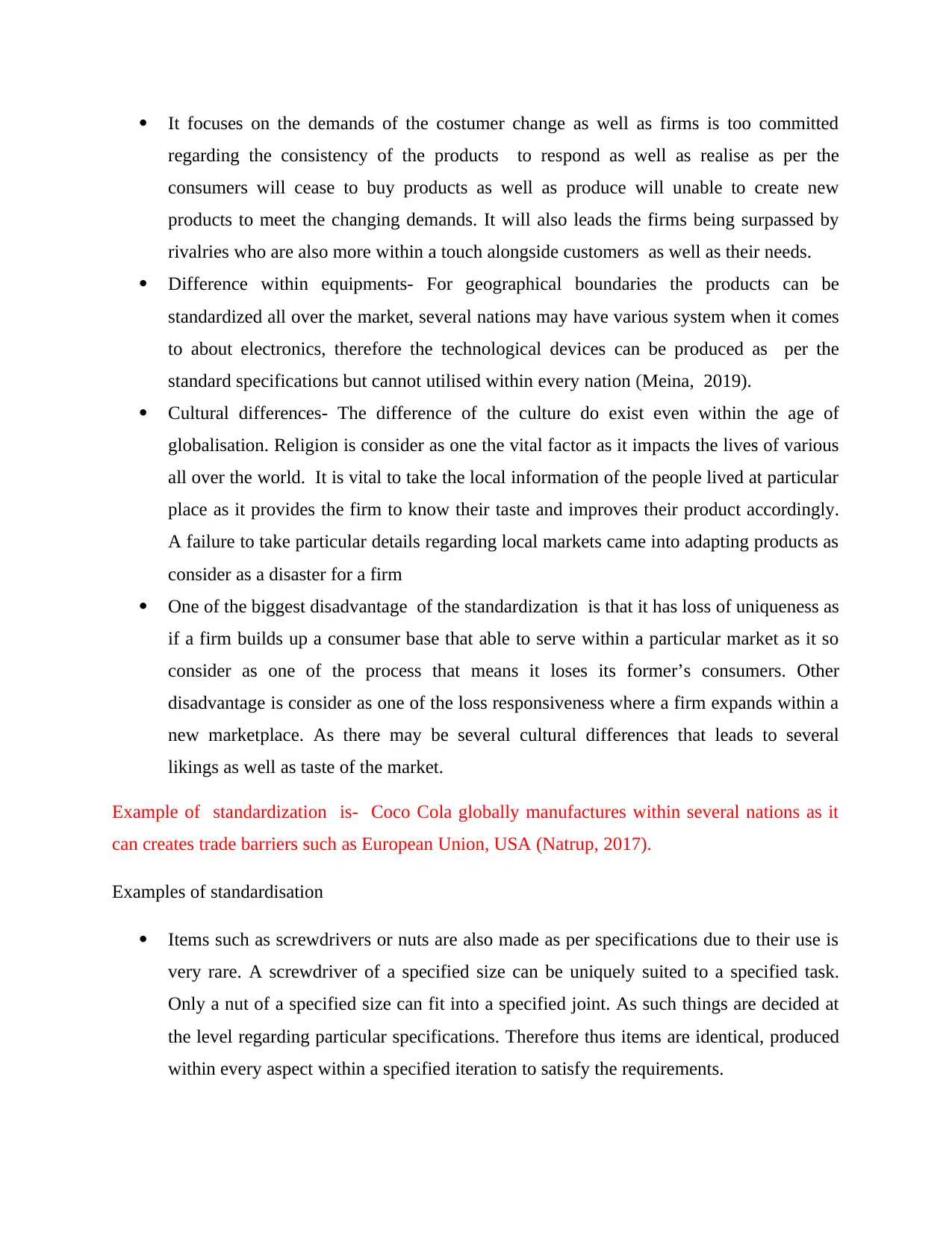
It focuses on the demands of the costumer change as well as firms is too committed
regarding the consistency of the products to respond as well as realise as per the
consumers will cease to buy products as well as produce will unable to create new
products to meet the changing demands. It will also leads the firms being surpassed by
rivalries who are also more within a touch alongside customers as well as their needs.
Difference within equipments- For geographical boundaries the products can be
standardized all over the market, several nations may have various system when it comes
to about electronics, therefore the technological devices can be produced as per the
standard specifications but cannot utilised within every nation (Meina, 2019).
Cultural differences- The difference of the culture do exist even within the age of
globalisation. Religion is consider as one the vital factor as it impacts the lives of various
all over the world. It is vital to take the local information of the people lived at particular
place as it provides the firm to know their taste and improves their product accordingly.
A failure to take particular details regarding local markets came into adapting products as
consider as a disaster for a firm
One of the biggest disadvantage of the standardization is that it has loss of uniqueness as
if a firm builds up a consumer base that able to serve within a particular market as it so
consider as one of the process that means it loses its former’s consumers. Other
disadvantage is consider as one of the loss responsiveness where a firm expands within a
new marketplace. As there may be several cultural differences that leads to several
likings as well as taste of the market.
Example of standardization is- Coco Cola globally manufactures within several nations as it
can creates trade barriers such as European Union, USA (Natrup, 2017).
Examples of standardisation
Items such as screwdrivers or nuts are also made as per specifications due to their use is
very rare. A screwdriver of a specified size can be uniquely suited to a specified task.
Only a nut of a specified size can fit into a specified joint. As such things are decided at
the level regarding particular specifications. Therefore thus items are identical, produced
within every aspect within a specified iteration to satisfy the requirements.
regarding the consistency of the products to respond as well as realise as per the
consumers will cease to buy products as well as produce will unable to create new
products to meet the changing demands. It will also leads the firms being surpassed by
rivalries who are also more within a touch alongside customers as well as their needs.
Difference within equipments- For geographical boundaries the products can be
standardized all over the market, several nations may have various system when it comes
to about electronics, therefore the technological devices can be produced as per the
standard specifications but cannot utilised within every nation (Meina, 2019).
Cultural differences- The difference of the culture do exist even within the age of
globalisation. Religion is consider as one the vital factor as it impacts the lives of various
all over the world. It is vital to take the local information of the people lived at particular
place as it provides the firm to know their taste and improves their product accordingly.
A failure to take particular details regarding local markets came into adapting products as
consider as a disaster for a firm
One of the biggest disadvantage of the standardization is that it has loss of uniqueness as
if a firm builds up a consumer base that able to serve within a particular market as it so
consider as one of the process that means it loses its former’s consumers. Other
disadvantage is consider as one of the loss responsiveness where a firm expands within a
new marketplace. As there may be several cultural differences that leads to several
likings as well as taste of the market.
Example of standardization is- Coco Cola globally manufactures within several nations as it
can creates trade barriers such as European Union, USA (Natrup, 2017).
Examples of standardisation
Items such as screwdrivers or nuts are also made as per specifications due to their use is
very rare. A screwdriver of a specified size can be uniquely suited to a specified task.
Only a nut of a specified size can fit into a specified joint. As such things are decided at
the level regarding particular specifications. Therefore thus items are identical, produced
within every aspect within a specified iteration to satisfy the requirements.
⊘ This is a preview!⊘
Do you want full access?
Subscribe today to unlock all pages.

Trusted by 1+ million students worldwide
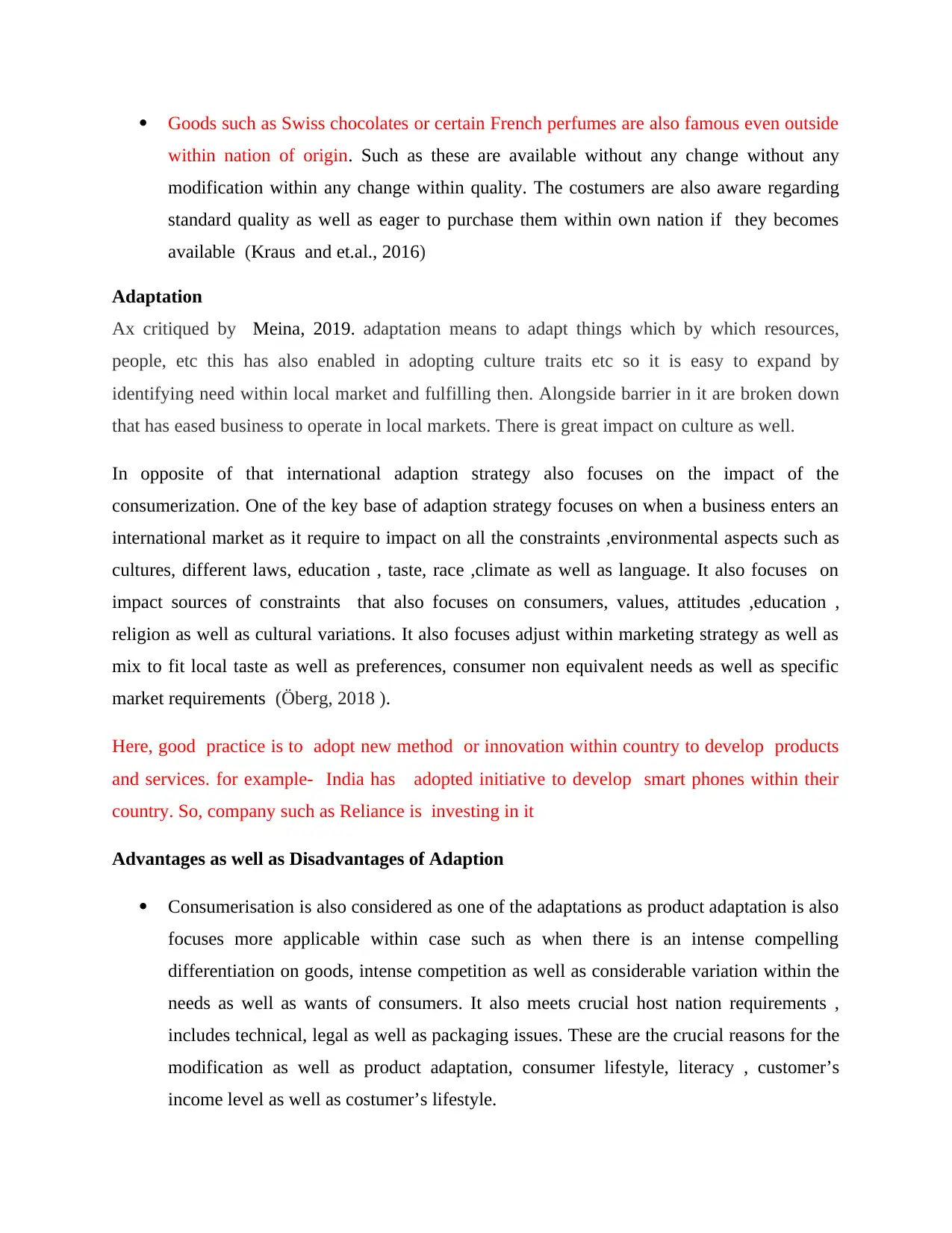
Goods such as Swiss chocolates or certain French perfumes are also famous even outside
within nation of origin. Such as these are available without any change without any
modification within any change within quality. The costumers are also aware regarding
standard quality as well as eager to purchase them within own nation if they becomes
available (Kraus and et.al., 2016)
Adaptation
Ax critiqued by Meina, 2019. adaptation means to adapt things which by which resources,
people, etc this has also enabled in adopting culture traits etc so it is easy to expand by
identifying need within local market and fulfilling then. Alongside barrier in it are broken down
that has eased business to operate in local markets. There is great impact on culture as well.
In opposite of that international adaption strategy also focuses on the impact of the
consumerization. One of the key base of adaption strategy focuses on when a business enters an
international market as it require to impact on all the constraints ,environmental aspects such as
cultures, different laws, education , taste, race ,climate as well as language. It also focuses on
impact sources of constraints that also focuses on consumers, values, attitudes ,education ,
religion as well as cultural variations. It also focuses adjust within marketing strategy as well as
mix to fit local taste as well as preferences, consumer non equivalent needs as well as specific
market requirements (Öberg, 2018 ).
Here, good practice is to adopt new method or innovation within country to develop products
and services. for example- India has adopted initiative to develop smart phones within their
country. So, company such as Reliance is investing in it
Advantages as well as Disadvantages of Adaption
Consumerisation is also considered as one of the adaptations as product adaptation is also
focuses more applicable within case such as when there is an intense compelling
differentiation on goods, intense competition as well as considerable variation within the
needs as well as wants of consumers. It also meets crucial host nation requirements ,
includes technical, legal as well as packaging issues. These are the crucial reasons for the
modification as well as product adaptation, consumer lifestyle, literacy , customer’s
income level as well as costumer’s lifestyle.
within nation of origin. Such as these are available without any change without any
modification within any change within quality. The costumers are also aware regarding
standard quality as well as eager to purchase them within own nation if they becomes
available (Kraus and et.al., 2016)
Adaptation
Ax critiqued by Meina, 2019. adaptation means to adapt things which by which resources,
people, etc this has also enabled in adopting culture traits etc so it is easy to expand by
identifying need within local market and fulfilling then. Alongside barrier in it are broken down
that has eased business to operate in local markets. There is great impact on culture as well.
In opposite of that international adaption strategy also focuses on the impact of the
consumerization. One of the key base of adaption strategy focuses on when a business enters an
international market as it require to impact on all the constraints ,environmental aspects such as
cultures, different laws, education , taste, race ,climate as well as language. It also focuses on
impact sources of constraints that also focuses on consumers, values, attitudes ,education ,
religion as well as cultural variations. It also focuses adjust within marketing strategy as well as
mix to fit local taste as well as preferences, consumer non equivalent needs as well as specific
market requirements (Öberg, 2018 ).
Here, good practice is to adopt new method or innovation within country to develop products
and services. for example- India has adopted initiative to develop smart phones within their
country. So, company such as Reliance is investing in it
Advantages as well as Disadvantages of Adaption
Consumerisation is also considered as one of the adaptations as product adaptation is also
focuses more applicable within case such as when there is an intense compelling
differentiation on goods, intense competition as well as considerable variation within the
needs as well as wants of consumers. It also meets crucial host nation requirements ,
includes technical, legal as well as packaging issues. These are the crucial reasons for the
modification as well as product adaptation, consumer lifestyle, literacy , customer’s
income level as well as costumer’s lifestyle.
Paraphrase This Document
Need a fresh take? Get an instant paraphrase of this document with our AI Paraphraser
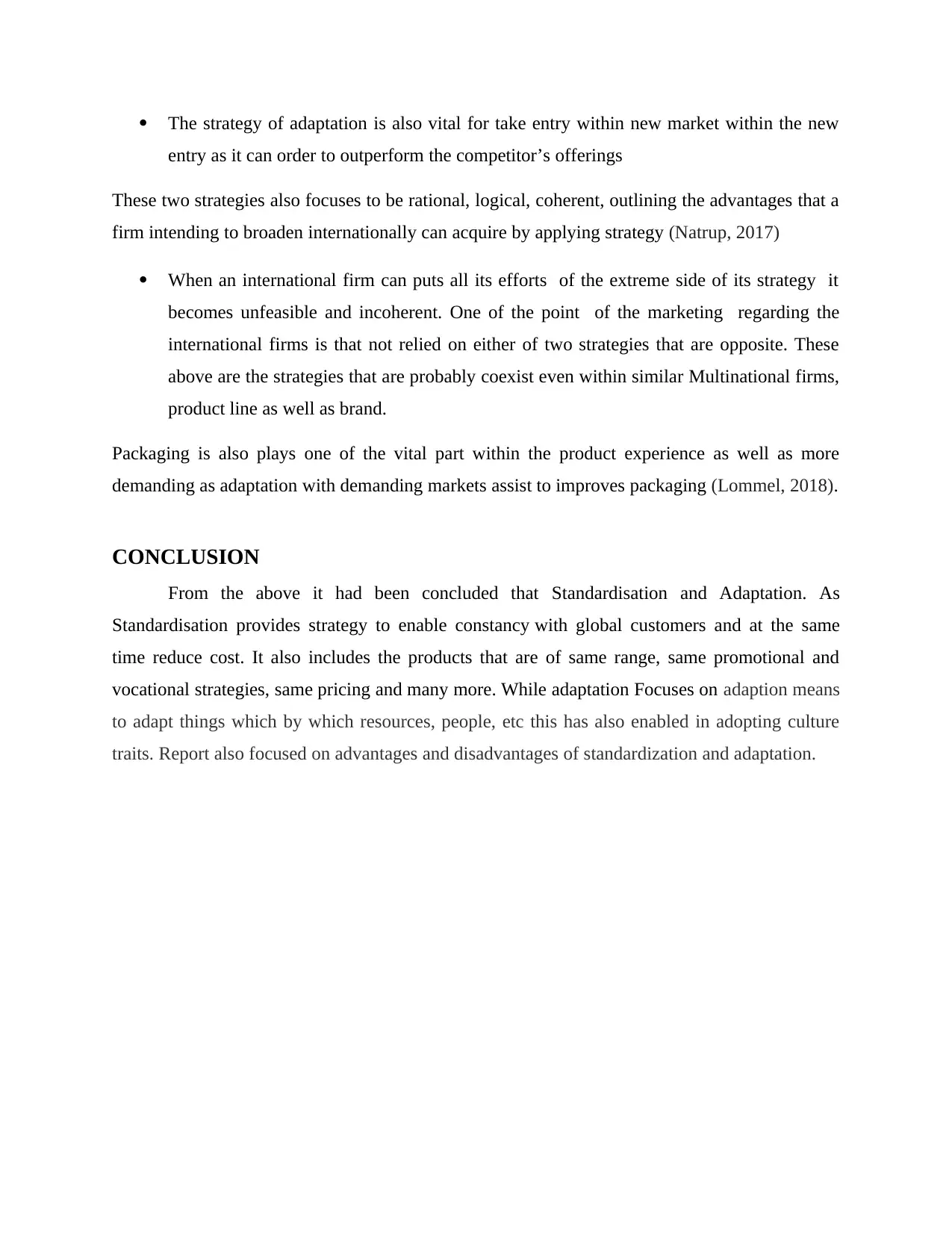
The strategy of adaptation is also vital for take entry within new market within the new
entry as it can order to outperform the competitor’s offerings
These two strategies also focuses to be rational, logical, coherent, outlining the advantages that a
firm intending to broaden internationally can acquire by applying strategy (Natrup, 2017)
When an international firm can puts all its efforts of the extreme side of its strategy it
becomes unfeasible and incoherent. One of the point of the marketing regarding the
international firms is that not relied on either of two strategies that are opposite. These
above are the strategies that are probably coexist even within similar Multinational firms,
product line as well as brand.
Packaging is also plays one of the vital part within the product experience as well as more
demanding as adaptation with demanding markets assist to improves packaging (Lommel, 2018).
CONCLUSION
From the above it had been concluded that Standardisation and Adaptation. As
Standardisation provides strategy to enable constancy with global customers and at the same
time reduce cost. It also includes the products that are of same range, same promotional and
vocational strategies, same pricing and many more. While adaptation Focuses on adaption means
to adapt things which by which resources, people, etc this has also enabled in adopting culture
traits. Report also focused on advantages and disadvantages of standardization and adaptation.
entry as it can order to outperform the competitor’s offerings
These two strategies also focuses to be rational, logical, coherent, outlining the advantages that a
firm intending to broaden internationally can acquire by applying strategy (Natrup, 2017)
When an international firm can puts all its efforts of the extreme side of its strategy it
becomes unfeasible and incoherent. One of the point of the marketing regarding the
international firms is that not relied on either of two strategies that are opposite. These
above are the strategies that are probably coexist even within similar Multinational firms,
product line as well as brand.
Packaging is also plays one of the vital part within the product experience as well as more
demanding as adaptation with demanding markets assist to improves packaging (Lommel, 2018).
CONCLUSION
From the above it had been concluded that Standardisation and Adaptation. As
Standardisation provides strategy to enable constancy with global customers and at the same
time reduce cost. It also includes the products that are of same range, same promotional and
vocational strategies, same pricing and many more. While adaptation Focuses on adaption means
to adapt things which by which resources, people, etc this has also enabled in adopting culture
traits. Report also focused on advantages and disadvantages of standardization and adaptation.
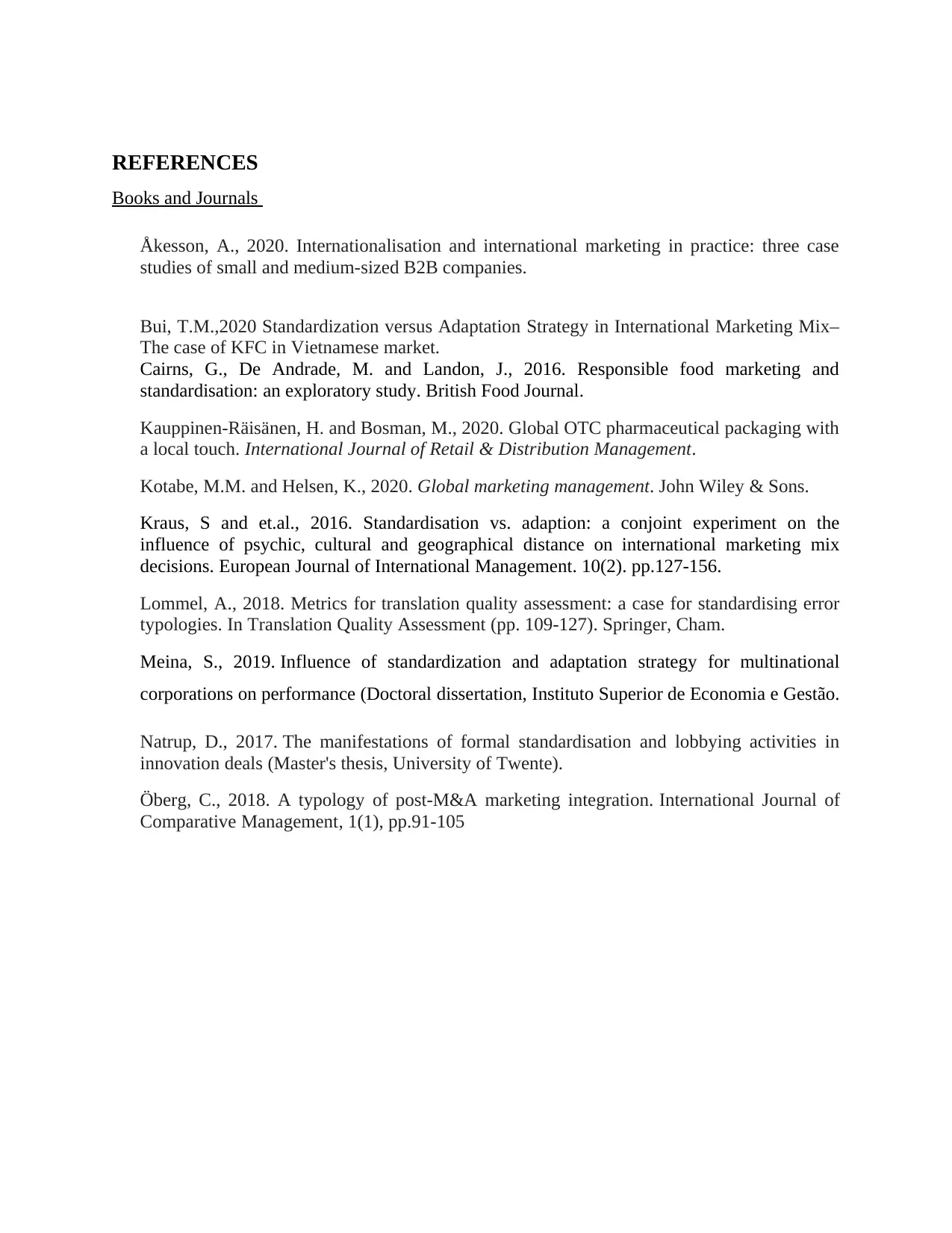
REFERENCES
Books and Journals
Åkesson, A., 2020. Internationalisation and international marketing in practice: three case
studies of small and medium-sized B2B companies.
Bui, T.M.,2020 Standardization versus Adaptation Strategy in International Marketing Mix–
The case of KFC in Vietnamese market.
Cairns, G., De Andrade, M. and Landon, J., 2016. Responsible food marketing and
standardisation: an exploratory study. British Food Journal.
Kauppinen-Räisänen, H. and Bosman, M., 2020. Global OTC pharmaceutical packaging with
a local touch. International Journal of Retail & Distribution Management.
Kotabe, M.M. and Helsen, K., 2020. Global marketing management. John Wiley & Sons.
Kraus, S and et.al., 2016. Standardisation vs. adaption: a conjoint experiment on the
influence of psychic, cultural and geographical distance on international marketing mix
decisions. European Journal of International Management. 10(2). pp.127-156.
Lommel, A., 2018. Metrics for translation quality assessment: a case for standardising error
typologies. In Translation Quality Assessment (pp. 109-127). Springer, Cham.
Meina, S., 2019. Influence of standardization and adaptation strategy for multinational
corporations on performance (Doctoral dissertation, Instituto Superior de Economia e Gestão.
Natrup, D., 2017. The manifestations of formal standardisation and lobbying activities in
innovation deals (Master's thesis, University of Twente).
Öberg, C., 2018. A typology of post-M&A marketing integration. International Journal of
Comparative Management, 1(1), pp.91-105
Books and Journals
Åkesson, A., 2020. Internationalisation and international marketing in practice: three case
studies of small and medium-sized B2B companies.
Bui, T.M.,2020 Standardization versus Adaptation Strategy in International Marketing Mix–
The case of KFC in Vietnamese market.
Cairns, G., De Andrade, M. and Landon, J., 2016. Responsible food marketing and
standardisation: an exploratory study. British Food Journal.
Kauppinen-Räisänen, H. and Bosman, M., 2020. Global OTC pharmaceutical packaging with
a local touch. International Journal of Retail & Distribution Management.
Kotabe, M.M. and Helsen, K., 2020. Global marketing management. John Wiley & Sons.
Kraus, S and et.al., 2016. Standardisation vs. adaption: a conjoint experiment on the
influence of psychic, cultural and geographical distance on international marketing mix
decisions. European Journal of International Management. 10(2). pp.127-156.
Lommel, A., 2018. Metrics for translation quality assessment: a case for standardising error
typologies. In Translation Quality Assessment (pp. 109-127). Springer, Cham.
Meina, S., 2019. Influence of standardization and adaptation strategy for multinational
corporations on performance (Doctoral dissertation, Instituto Superior de Economia e Gestão.
Natrup, D., 2017. The manifestations of formal standardisation and lobbying activities in
innovation deals (Master's thesis, University of Twente).
Öberg, C., 2018. A typology of post-M&A marketing integration. International Journal of
Comparative Management, 1(1), pp.91-105
⊘ This is a preview!⊘
Do you want full access?
Subscribe today to unlock all pages.

Trusted by 1+ million students worldwide
1 out of 9
Related Documents
Your All-in-One AI-Powered Toolkit for Academic Success.
+13062052269
info@desklib.com
Available 24*7 on WhatsApp / Email
![[object Object]](/_next/static/media/star-bottom.7253800d.svg)
Unlock your academic potential
Copyright © 2020–2025 A2Z Services. All Rights Reserved. Developed and managed by ZUCOL.





